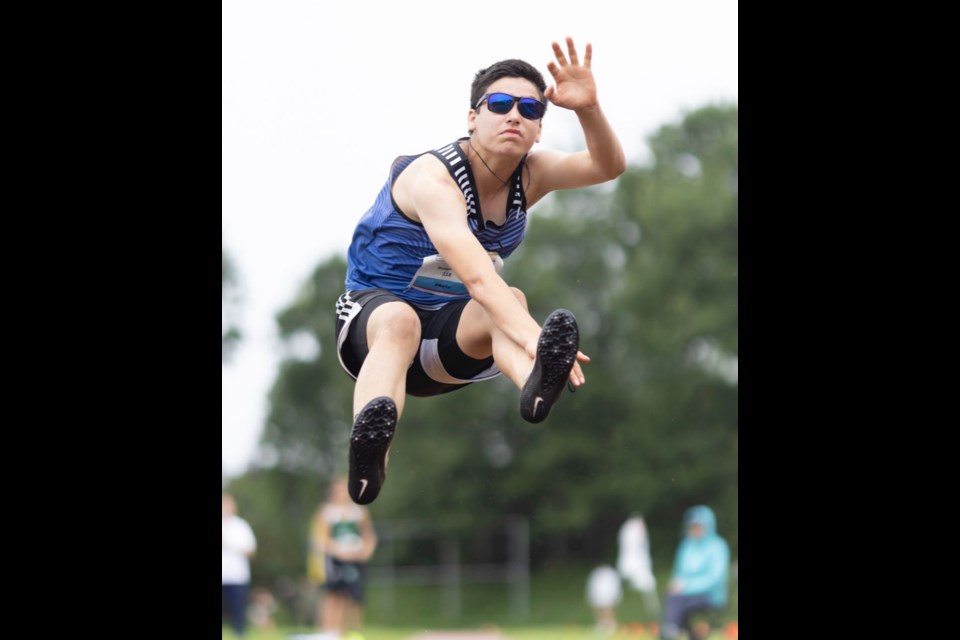COLD LAKE - A Lakeland track and field athlete recently returned home from the North American Indigenous Games the proud winner of three silver medals.
Even though Broden Paul of Cold Lake only began competing in track and field events earlier this year, the 13-year-old was determined to qualify for the North American Indigenous Games (NAIG), which took place in Halifax, Nova Scotia from July 15-22. He was part of a contingent of 21 athletes who comprised Team Alberta.
While many athletes dedicate hours of training to one sport, given the diversity of track and field, Paul took advantage of the opportunity to compete in six different events – shot put, 80 metre dash, 150 metre dash, long jump, as well as two 4x100 and 4x400 relays against runners in the U16 category. While Paul placed fourth in the long jump out of 26 athletes, he didn’t place in the relays, coming in fifth in both races.
It was in shot put, 80 metre dash and 150 metre dash where Paul excelled, clinching a silver medal in each event.
“Many of the competitions were very intense,” Paul told Lakeland This Week. “There was an athlete from New Brunswick who I competed against in the 80, 150 dashes as well as long jump. He placed first in the long jump and third in the 80 and 150 only being 0.02 seconds behind me in the 80 and 0.01 seconds in the 150. It’s very important to get to know your competition.”
Paul says that his hard work and training paid off nicely.
“Although I did well, I’m relieved that it’s over,” Paul stated, adding, “Although the competitions were intimidating at times, I forced myself not to become nervous or overthink. Instead, I trusted my training."
So, what is it like to compete against and make friends with thousands of Indigenous athletes from all across the continent? Paul describes his experience on Canada’s east coast as "amazing."
“There was so much energy among the athletes, family members, coaches and fans, all of whom were so happy to be there,” he said.
Having travelled that far, Paul was bound to return home not only with medals, but also some souvenirs of his time there.
“A big thing that went on was pin trading. Each athlete would get some pins of their team,” Paul explained. “The goal was to get the rare pins of various provinces, states, and territories. Pin trading was a great way to get to interact and get to know others.”
As for training leading up to the event, Paul is a member of the Lakeland Yellow Jackets Athletic Club, and he enlisted the guidance of coach Larry Godziuk, who prepared him for what he would face in Halifax.
“During the last few weeks of training, I was training almost every morning, and it could be very tiring,” Paul stated. “I would practice throwing for an hour-and-a-half before spending two hours running and jumping.”
When it comes to being successful at shot put, patience is the key, according to Paul.
“It’s difficult to be powerful, fast and also have good form while throwing shot put. Therefore, one must concentrate and practice regularly in order to find a balance between those three things,” he said. “My coach is continually telling us not to throw our best in warm-up, but to save that for competitions.”
What’s next for this budding track and field competitor?
“From here, I plan to continue doing club and competing,” Paul said. “I have my sights on participating in track provincials with the club next year. I’m also currently training for the upcoming school basketball season.”
The North American Indigenous Games (NAIG) has been held intermittently throughout Canada and the United States since 1990. The NAIG is governed by the North American Indigenous Games Council, which is a 26-member council of representatives from 13 provinces and territories in Canada and 13 regions in the United States.
The origins of what would later become the North American Indigenous Games began in 1971 with the Native Summer Games, which were held in Enoch, Alberta, drawing 3,000 participants who competed in 13 sports. The games also featured many cultural events.
In 1977, Sweden hosted the Annual Assembly of the World Council of Indigenous Peoples, where a motion for cities in North America to host international indigenous competitions was unanimously passed.
The first North American Indigenous Games took place in Edmonton in 1990.



